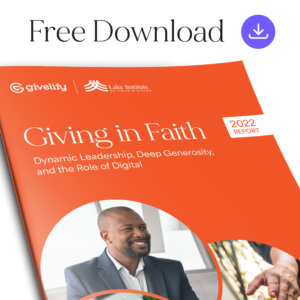3 Myths About Digital Giving Too Many Pastors Believe
I remember – it’s been almost 10 years now – when some pastors and faith leaders didn’t see the importance of providing digital ways for their congregations to give.
They believed that everyone would simply come into the church building to give their cash or checks – and this was the way things would always be.
Yet during this period, years before COVID-19, Rev. Matthew L. Watley, encouraged our ministry teams at Kingdom Fellowship AME Church to challenge the assumption that people will only give through an offering envelope, basket, or plate.
Rev. Watley is the Founder and Senior Pastor of Kingdom Fellowship in Calverton, Maryland, where I currently attend. I also serve as the Director of Ministry Operations and Outreach for the church.
As a result of Rev. Watley’s challenge, nearly 70% of our more than 5,000 active members now donate to the church digitally, meaning via online giving technology or a mobile donation app.
And that was before the pandemic forced new ways of digital giving for churches!
The key takeaway from this experience is this: Congregants might be in the building, yet they still will give through their mobile devices.
Religious giving online is not going away
The last two years have helped many churches and places of worship realize not only the usefulness but also the “need” to have effective online and mobile app giving solutions for your congregation.
According to the 2022 Giving in Faith report, 92% of givers intend to make religious donations to their places of worship digitally. Further, 21% of religious donors intend to give to multiple places of worship, according to the report’s church-giving statistics.
To be sure, online and app giving aren’t fads nor are they going away. In fact, the adoption of digital fundraising increased during the pandemic to 99% for those who participated in the survey.
Even with the high adoption rate, there still exists some basic misunderstandings about what digital giving for churches and places of worship should look like now that in-person services have resumed.
Here are three common myths about giving digitally that you should avoid. I also included lessons my church has learned as we continue to grow online and mobile giving among our donors.
Myth #1: People only give when they’re in the building
Prior to 2020, many church leaders really believed that if a member was traveling or if snow closed the church one Sunday, we would “miss out” on that Sunday’s giving. And maybe, we would receive the congregation’s tithes and offerings the following Sunday.
But this myth has been debunked. Thanks to easy and quick options like Givelify’s mobile giving app, churches have learned that collecting tithes and offerings are no longer disrupted due to a snowstorm or if someone is traveling to another part of the world.
Why is this important? Because as the world continues to “open back up” and in-person worship becomes more regular, churches and places of worship should continue to offer online giving platforms to be more accessible to existing members and reach a wider global audience.
Kingdom Fellowship has returned to in-person worship. Yet my Senior Pastor has made it very clear that our preferred method for giving is digital. We don’t want to lose the gains we made during the pandemic and allow the return to in-person worship to dictate a move back to in-person giving.
Of course, we understand that some congregants still may be slow to adopt digital giving for churches. But for everyone else, we encourage them to continue to give in the easiest, most accessible, and most accurate way possible – online and via mobile.
Why are digital giving solutions our preferred method of giving?
There are benefits for your church or place of worship, including digital giving creates an immediate record that matches in real time with the organization’s record.
With Givelify, all your organization’s donations – whether made through the app or your website – will be tracked together in one location, namely the Givelify Analytics Studio, for your convenience.
Imagine how much time that saves your back office team!
And there are benefits for the giver. Givelify users receive an annual giving summary, or giving statement, at the end of the year that makes preparing for tax season a breeze. Additionally, donors can run their donation history right off the app at any time of the year.
Time won’t permit me to discuss all the benefits. But I will say that it is a blessing for my family to know that I can give directly from my phone no matter where I am and no matter what time of day it might be.
Myth #2: Walking increases the offering 
When it’s offering time during worship service, some churches and places of worship “pass the plate” to collect donations.
Others encourage their congregants to “walk.” That’s when the congregation stands up during service and bring their tithes and offering to the offering plate, which is in a stationary location, usually at the front of the sanctuary.
The thought among many pastors and faith leaders is if congregants walked to give their offering, then they would be compelled to give. Who wants to remain seated when everyone else is walking? And if you’re walking, you might as well drop something in.
But I always wondered if those who walked to give were actually giving their tithes and offering, or just giving “something.” I always say they are giving more like a tip than a freewill offering.
This is why you should stop believing this myth now. Those who are giving should be taught the importance of giving as a spiritual act of joy and the impact of their giving.
If someone walks around to give, gives from their seat, or gives from the other side of the world, it shouldn’t matter as long as their heart for giving is correct.
At Kingdom Fellowship, we tested this theory for a few consecutive Sundays. We found that when we stopped asking the congregation to walk or march around during offering time, the giving didn’t drop off.
My Senior Pastor did a great job communicating and explaining that if we changed how we worshiped with our gifts – by not marching around section-by-section or pew-by-pew – we would indeed have a more maintained focus in the flow of our worship experience.
We learned that we could move through the worship experience without the extra pomp and circumstance and giving not drop.
Myth #3 You need the offering song to have “more worship”
The thought behind this myth is this: Since offering time includes people walking or marching, it gives your church an extra worship song and more time to worship.
In some cases, this may be true. But while you may have more “time” to worship, that doesn’t mean that you have “more worship” or better worship.
What Kingdom Fellowship has found is by moving the worship song during our offering appeal, we can better prepare the sermonic moment before our Senior Pastor gets up to preach.
Each week we have an opportunity to be more intentional about this part of the worship experience without being distracted by the busyness of an offering moment with congregants walking or marching, stopping to talk, and waiting on directives from the ushers.
Instead, each week our Minister of Music is able to craft a moment that sets the atmosphere for the congregation – both in-person and online – to connect with God and prepare their hearts for the Word of the Lord through the sermon.
I hope debunking these three myths about digital giving platforms will help as your church leadership continues to navigate maintaining digital giving for churches even as you have in-person services.
I hope our experiences at Kingdom Fellowship will help, as well. Digital giving trends are clear: During the last two years, givers have formed habits around online giving for churches. Continue to encourage your church donors to give digitally!
Recommended for you:
- [Watch Webinar Replay] Maximize Easter Generosity: Turn One-Time Givers into Year-Long Supporters
- Video: How One Church Increased Donations by 25% in One Year with Givelify
- 4 Reasons Why Givelify is the Best Giving Platform for You
- Video: “Givelify has been a blessing to our ministry”
- How The Bethel Church raised $115,000 in 6 hours





